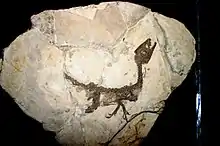Cretaceous
The Cretaceous ( /krɪˈteɪ.ʃəs/, krih-TAY-shəs)[1] is a geological period that lasted from about 145 to 66 million years ago (mya). It is the third and final period of the Mesozoic Era, as well as the longest. At nearly 80 million years, it is the longest geological period of the entire Phanerozoic. The name is derived from the Latin creta, 'chalk', which is abundant in the latter half of the period. It is usually abbreviated K, for its German translation Kreide.
| Cretaceous | |
|---|---|
| ~145.0 – 66.0 Ma | |
| Chronology | |
Key events in the Cretaceous -140 — – -130 — – -120 — – -110 — – -100 — – -90 — – -80 — – -70 — – An approximate timescale of key Cretaceous events. Axis scale: millions of years ago. | |
| Etymology | |
| Name formality | Formal |
| Usage information | |
| Celestial body | Earth |
| Regional usage | Global (ICS) |
| Time scale(s) used | ICS Time Scale |
| Definition | |
| Chronological unit | Period |
| Stratigraphic unit | System |
| Time span formality | Formal |
| Lower boundary definition | Not formally defined |
| Lower boundary definition candidates |
|
| Lower boundary GSSP candidate section(s) | None |
| Upper boundary definition | Iridium enriched layer associated with a major meteorite impact and subsequent K-Pg extinction event. |
| Upper boundary GSSP | El Kef Section, El Kef, Tunisia 36.1537°N 8.6486°E |
| GSSP ratified | 1991 |
| Atmospheric and climatic data | |
| Mean atmospheric O 2 content | c. 30 vol % (150 % of modern) |
| Mean atmospheric CO 2 content | c. 1700 ppm (6 times pre-industrial) |
| Mean surface temperature | c. 18 °C (4 °C above modern) |
The Cretaceous was a period with a relatively warm climate, resulting in high eustatic sea levels that created numerous shallow inland seas. These oceans and seas were populated with now-extinct marine reptiles, ammonites and rudists, while dinosaurs continued to dominate on land. The world was ice free, and forests extended to the poles. During this time, new groups of mammals and birds appeared. During the Early Cretaceous, flowering plants appeared and began to rapidly diversify, becoming the dominant group of plants across the Earth by the end of the Cretaceous, co-incident with the decline and extinction of previously widespread gymnosperm groups.
The Cretaceous (along with the Mesozoic) ended with the Cretaceous–Paleogene extinction event, a large mass extinction in which many groups, including non-avian dinosaurs, pterosaurs, and large marine reptiles died out. The end of the Cretaceous is defined by the abrupt Cretaceous–Paleogene boundary (K–Pg boundary), a geologic signature associated with the mass extinction which lies between the Mesozoic and Cenozoic eras.
Etymology and history
The Cretaceous as a separate period was first defined by Belgian geologist Jean d'Omalius d'Halloy in 1822 as the "Terrain Crétacé",[2] using strata in the Paris Basin[3] and named for the extensive beds of chalk (calcium carbonate deposited by the shells of marine invertebrates, principally coccoliths), found in the upper Cretaceous of Western Europe. The name Cretaceous was derived from Latin creta, meaning chalk.[4] The twofold division of the Cretaceous was implemented by Conybeare and Phillips in 1822. Alcide d'Orbigny in 1840 divided the French Cretaceous into 5 “étages” (stages): the Neocomian, Aptian, Albian, Turonian and Senonian, later adding the "Urgonian" between Neocomian and Aptian and the Cenomanian between the Albian and Turonian.[5]
Geology
Boundaries
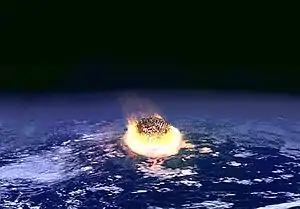
There is not yet a globally-defined lower stratigraphic boundary representing the start of the period.[6] However, the top of the system is sharply defined, being placed at an iridium-rich layer found worldwide that is believed to be associated with the Chicxulub impact crater, with its boundaries circumscribing parts of the Yucatán Peninsula and into the Gulf of Mexico. This layer has been dated at 66.043 Ma.[7]
A 140 Ma age for the Jurassic-Cretaceous boundary instead of the usually accepted 145 Ma was proposed in 2014 based on a stratigraphic study of Vaca Muerta Formation in Neuquén Basin, Argentina.[8] Víctor Ramos, one of the authors of the study proposing the 140 Ma boundary age, sees the study as a "first step" toward formally changing the age in the International Union of Geological Sciences.[9]
At the end of the Cretaceous, the impact of a large body with the Earth may have been the punctuation mark at the end of a progressive decline in biodiversity during the Maastrichtian Age. The result was the extinction of three-quarters of Earth's plant and animal species. The impact created the sharp break known as K–Pg boundary (formerly known as the K–T boundary). Earth's biodiversity required substantial time to recover from this event, despite the probable existence of an abundance of vacant ecological niches.[10]
Despite the severity of K-Pg extinction event, there was significant variability in the rate of extinction between and within different clades. Species which depended on photosynthesis declined or became extinct as atmospheric particles blocked solar energy. As is the case today, photosynthesizing organisms, such as phytoplankton and land plants, formed the primary part of the food chain in the late Cretaceous, and all else that depended on them suffered as well. Herbivorous animals, which depended on plants and plankton as their food, died out as their food sources became scarce; consequently, the top predators, such as Tyrannosaurus rex, also perished.[11] Yet only three major groups of tetrapods disappeared completely: the non-avian dinosaurs, the plesiosaurs and the pterosaurs. The other Cretaceous groups that did not survive into the Cenozoic era, the ichthyosaurs and last remaining temnospondyls and non-mammalian cynodonts were already extinct millions of years before the event occurred.
Coccolithophorids and molluscs, including ammonites, rudists, freshwater snails and mussels, as well as organisms whose food chain included these shell builders, became extinct or suffered heavy losses. For example, it is thought that ammonites were the principal food of mosasaurs, a group of giant marine reptiles that became extinct at the boundary.[12]
Omnivores, insectivores and carrion-eaters survived the extinction event, perhaps because of the increased availability of their food sources. At the end of the Cretaceous there seem to have been no purely herbivorous or carnivorous mammals. Mammals and birds which survived the extinction fed on insects, larvae, worms and snails, which in turn fed on dead plant and animal matter. Scientists theorise that these organisms survived the collapse of plant-based food chains because they fed on detritus.[13][10][14]
In stream communities, few groups of animals became extinct. Stream communities rely less on food from living plants and more on detritus that washes in from land. This particular ecological niche buffered them from extinction.[15] Similar, but more complex patterns have been found in the oceans. Extinction was more severe among animals living in the water column, than among animals living on or in the seafloor. Animals in the water column are almost entirely dependent on primary production from living phytoplankton, while animals living on or in the ocean floor feed on detritus or can switch to detritus feeding.[10]
The largest air-breathing survivors of the event, crocodilians and champsosaurs, were semi-aquatic and had access to detritus. Modern crocodilians can live as scavengers and can survive for months without food and go into hibernation when conditions are unfavorable, and their young are small, grow slowly, and feed largely on invertebrates and dead organisms or fragments of organisms for their first few years. These characteristics have been linked to crocodilian survival at the end of the Cretaceous.[13]
Stratigraphy
The Cretaceous is divided into Early and Late Cretaceous epochs, or Lower and Upper Cretaceous series. In older literature the Cretaceous is sometimes divided into three series: Neocomian (lower/early), Gallic (middle) and Senonian (upper/late). A subdivision in twelve stages, all originating from European stratigraphy, is now used worldwide. In many parts of the world, alternative local subdivisions are still in use.
From youngest to oldest, the subdivisions of the Cretaceous period are:
| Subperiod | Stage | Start (Ma) | End (Ma) | Definition | Etymology |
|---|---|---|---|---|---|
| Late Cretaceous | Maastrichtian | 72.1 ± 0.2 | 66.0 | top: iridium anomaly at the Cretaceous–Paleogene boundary
base:first occurrence of Pachydiscus neubergicus |
Maastricht Formation, Maastricht, Netherlands |
| Campanian | 83.6 ± 0.2 | 72.1 ± 0.2 | base: last occurrence of Marsupites testudinarius | Champagne, France | |
| Santonian | 86.3 ± 0.5 | 83.6 ± 0.2 | base: first occurrence of Cladoceramus undulatoplicatus | Saintes, France | |
| Coniacian | 89.8 ± 0.3 | 86.3 ± 0.5 | base: first occurrence of Cremnoceramus rotundatus | Cognac, France | |
| Turonian | 93.9 ± 0.8 | 89.8 ± 0.3 | base: first occurrence of Watinoceras devonense | Tours, France | |
| Cenomanian | 100.5 ± 0.9 | 93.9 ± 0.8 | base: first occurrence of Rotalipora globotruncanoides | Cenomanum; Le Mans, France | |
| Early Cretaceous | Albian | 113.0 ± 1.0 | 100.5 ± 0.9 | base: first occurrence of Praediscosphaera columnata | Aube, France |
| Aptian | 125.0 ± 1.0 | 113.0 ± 1.0 | base: magnetic anomaly M0r | Apt, France | |
| Barremian | 129.4 ± 1.5 | 125.0 ± 1.0 | base: first occurrence of Spitidiscus hugii and S. vandeckii | Barrême, France | |
| Hauterivian | 132.9 ± 2.0 | 129.4 ± 1.5 | base: first occurrence of Acanthodiscus | Hauterive, France | |
| Valanginian | 139.8 ± 3.0 | 132.9 ± 2.0 | base: first occurrence of Calpionellites darderi | Valangin, France | |
| Berriasian | 145.0 ± 4.0 | 139.8 ± 3.0 | base: first occurrence of Berriasella jacobi (traditionally) first occurrence of Calpionella alpina (since 2016) | Berrias, France | |
Geologic formations
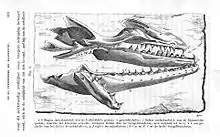
The high sea level and warm climate of the Cretaceous meant large areas of the continents were covered by warm, shallow seas, providing habitat for many marine organisms. The Cretaceous was named for the extensive chalk deposits of this age in Europe, but in many parts of the world, the deposits from the Cretaceous are of marine limestone, a rock type that is formed under warm, shallow marine conditions. Due to the high sea level, there was extensive space for such sedimentation. Because of the relatively young age and great thickness of the system, Cretaceous rocks are evident in many areas worldwide.
Chalk is a rock type characteristic for (but not restricted to) the Cretaceous. It consists of coccoliths, microscopically small calcite skeletons of coccolithophores, a type of algae that prospered in the Cretaceous seas.
Stagnation of deep sea currents in middle Cretaceous times caused anoxic conditions in the sea water leaving the deposited organic matter undecomposed. Half of the world's petroleum reserves were laid down at this time in the anoxic conditions of what would become the Persian Gulf and the Gulf of Mexico. In many places around the world, dark anoxic shales were formed during this interval,[16] such as the Mancos Shale of western North America.[17] These shales are an important source rock for oil and gas, for example in the subsurface of the North Sea.
Europe
In northwestern Europe, chalk deposits from the Upper Cretaceous are characteristic for the Chalk Group, which forms the white cliffs of Dover on the south coast of England and similar cliffs on the French Normandian coast. The group is found in England, northern France, the low countries, northern Germany, Denmark and in the subsurface of the southern part of the North Sea. Chalk is not easily consolidated and the Chalk Group still consists of loose sediments in many places. The group also has other limestones and arenites. Among the fossils it contains are sea urchins, belemnites, ammonites and sea reptiles such as Mosasaurus.
In southern Europe, the Cretaceous is usually a marine system consisting of competent limestone beds or incompetent marls. Because the Alpine mountain chains did not yet exist in the Cretaceous, these deposits formed on the southern edge of the European continental shelf, at the margin of the Tethys Ocean.
North America
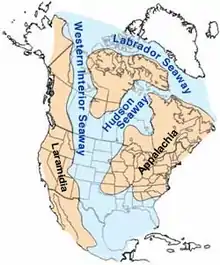
During the Cretaceous, the present North American continent was isolated from the other continents. In the Jurassic, the North Atlantic already opened, leaving a proto-ocean between Europe and North America. From north to south across the continent, the Western Interior Seaway started forming. This inland sea separated the elevated areas of Laramidia in the west and Appalachia in the east. Three dinosaur clades found in Laramidia (troodontids, therizinosaurids and oviraptorosaurs) are absent from Appalachia from the Coniacian through the Maastrichtian.[18]
Paleogeography
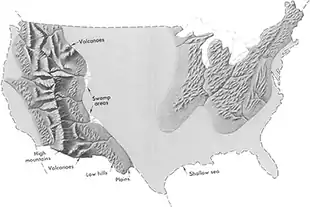
During the Cretaceous, the late-Paleozoic-to-early-Mesozoic supercontinent of Pangaea completed its tectonic breakup into the present-day continents, although their positions were substantially different at the time. As the Atlantic Ocean widened, the convergent-margin mountain building (orogenies) that had begun during the Jurassic continued in the North American Cordillera, as the Nevadan orogeny was followed by the Sevier and Laramide orogenies.
Gondwana had begun to break up during the Jurassic period, but its fragmentation accelerated during the Cretaceous and was largely complete by the end of the period. South America, Antarctica and Australia rifted away from Africa (though India and Madagascar remained attached to each other until around 80 million years ago); thus, the South Atlantic and Indian Oceans were newly formed. Such active rifting lifted great undersea mountain chains along the welts, raising eustatic sea levels worldwide. To the north of Africa the Tethys Sea continued to narrow. During the most of the Late Cretaceous, North America would be divided in two by the Western Interior Seaway, a large interior sea, separating Laramidia to the west and Appalachia to the east, then receded late in the period, leaving thick marine deposits sandwiched between coal beds. At the peak of the Cretaceous transgression, one-third of Earth's present land area was submerged.[19]
The Cretaceous is justly famous for its chalk; indeed, more chalk formed in the Cretaceous than in any other period in the Phanerozoic.[20] Mid-ocean ridge activity—or rather, the circulation of seawater through the enlarged ridges—enriched the oceans in calcium; this made the oceans more saturated, as well as increased the bioavailability of the element for calcareous nanoplankton.[21] These widespread carbonates and other sedimentary deposits make the Cretaceous rock record especially fine. Famous formations from North America include the rich marine fossils of Kansas's Smoky Hill Chalk Member and the terrestrial fauna of the late Cretaceous Hell Creek Formation. Other important Cretaceous exposures occur in Europe (e.g., the Weald) and China (the Yixian Formation). In the area that is now India, massive lava beds called the Deccan Traps were erupted in the very late Cretaceous and early Paleocene.
Climate
The cooling trend of the last epoch of the Jurassic continued into the first age of the Cretaceous. There is evidence that snowfalls were common in the higher latitudes, and the tropics became wetter than during the Triassic and Jurassic.[22] Glaciation was however restricted to high-latitude mountains, though seasonal snow may have existed farther from the poles. Rafting by ice of stones into marine environments occurred during much of the Cretaceous, but evidence of deposition directly from glaciers is limited to the Early Cretaceous of the Eromanga Basin in southern Australia.[23][24]
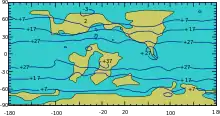
After the end of the first age, however, temperatures increased again, and these conditions were almost constant until the end of the period.[22] The warming may have been due to intense volcanic activity which produced large quantities of carbon dioxide. Between 70–69 Ma and 66–65 Ma, isotopic ratios indicate elevated atmospheric CO2 pressures with levels of 1000–1400 ppmV and mean annual temperatures in west Texas between 21 and 23 °C (70 and 73 °F). Atmospheric CO2 and temperature relations indicate a doubling of pCO2 was accompanied by a ~0.6 °C increase in temperature.[25] The production of large quantities of magma, variously attributed to mantle plumes or to extensional tectonics,[26] further pushed sea levels up, so that large areas of the continental crust were covered with shallow seas. The Tethys Sea connecting the tropical oceans east to west also helped to warm the global climate. Warm-adapted plant fossils are known from localities as far north as Alaska and Greenland, while dinosaur fossils have been found within 15 degrees of the Cretaceous south pole.[27] It was suggest that there was Antarctic marine glaciation in the Turonian Age, based on isotopic evidence.[28] However, this has subsequently been suggest to be the result of inconsistent isotopic proxies,[29] with evidence of polar rainforests during this time interval at 82° S.[30]
A very gentle temperature gradient from the equator to the poles meant weaker global winds, which drive the ocean currents, resulted in less upwelling and more stagnant oceans than today. This is evidenced by widespread black shale deposition and frequent anoxic events.[16] Sediment cores show that tropical sea surface temperatures may have briefly been as warm as 42 °C (108 °F), 17 °C (31 °F) warmer than at present, and that they averaged around 37 °C (99 °F). Meanwhile, deep ocean temperatures were as much as 15 to 20 °C (27 to 36 °F) warmer than today's.[31][32]
Flora
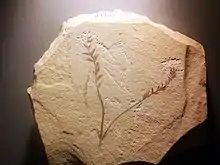
Flowering plants (angiosperms) make up around 90% of living plant species today. Prior to the rise of angiosperms, during the Jurassic and the Early Cretaceous, the higher flora was dominated by gymnosperm groups, including cycads, conifers, ginkgophytes, gnetophytes and close relatives, as well as the extinct Bennettitales. Other groups of plants included pteridosperms or "seed ferns", a collective term to refer to disparate groups of fern-like plants that produce seeds, including groups such as Corystospermaceae and Caytoniales. The exact origins of angiosperms are uncertain, with competing hypotheses including the anthophyte hypothesis, assuming flowering plants to be closely related to gynetophytes and Bennettitales as well as the more obscure Erdtmanithecales. Benettitales, Erdtmanithecales, and gnetophytes are connected by shared morphological characters in their seed coats.[33]
Molecular phylogenetics has consistently contradicted the anthophyte hypothesis, finding all extant gymnosperms, including gnetophytes, to be monophyletic to the exclusion of flowering plants.[34] Other hypotheses place the origin of flowering plants amongst the "seed ferns", but conclusive evidence for an origin amongst any pteridosperm group is lacking. It has been noted that several key diagnostic characters of angiosperms have poor fossilisation potential.[35]
The earliest widely accepted evidence of flowering plants are monosulcate (single grooved) pollen grains from the late Valanginian of Israel,[36] and Italy,[37] initially at low abundance. Molecular clock estimates conflict with fossil estimates, suggesting the diversification of crown-group angiosperms during the Upper Triassic or Jurassic, but such estimates are difficult to reconcile with the heavily sampled pollen record and the distinctive tricolpate to tricolporoidate (triple grooved) pollen of eudicot angiosperms.[38]
Among the oldest records of Angiosperm macrofossils are Montsechia from the Barremian aged Las Hoyas beds of Spain and Archaefructus from the Barremian-Aptian boundary Yixian Formation in China. Tricolpate pollen distinctive of eudicots first appears in the Late Barremian, while the earliest remains of monocots are known from the Aptian.[38] The oldest known fossils of grasses are from the Albian,[39] with the family having diversified into modern groups by the end of the Cretaceous.[40] The oldest large angiosperm trees are known from the Turonian (c. 90 Ma) of New Jersey, with the trunk having a preserved diameter of 1.8 metres (5.9 ft) and an estimated height of 50 metres (160 ft).[41]
Nearly all extant flowering plant families appeared by the end of the Cretaceous. During the Cretaceous, Polypodiales ferns -which make up 80% of living fern species- would also begin to diversify.[42]
Terrestrial fauna
On land, mammals were generally small sized, but a very relevant component of the fauna, with cimolodont multituberculates outnumbering dinosaurs in some sites.[43] Neither true marsupials nor placentals existed until the very end,[44] but a variety of non-marsupial metatherians and non-placental eutherians had already begun to diversify greatly, ranging as carnivores (Deltatheroida), aquatic foragers (Stagodontidae) and herbivores (Schowalteria, Zhelestidae). Various "archaic" groups like eutriconodonts were common in the Early Cretaceous, but by the Late Cretaceous northern mammalian faunas were dominated by multituberculates and therians, with dryolestoids dominating South America.
The apex predators were archosaurian reptiles, especially dinosaurs, which were at their most diverse stage. Pterosaurs were common in the early and middle Cretaceous, but as the Cretaceous proceeded they declined for poorly understood reasons (once thought to be due to competition with early birds, but now it is understood avian adaptive radiation is not consistent with pterosaur decline[45]), and by the end of the period only two highly specialized families remained.
The Liaoning lagerstätte (Yixian Formation) in China is a treasure chest of preserved remains of numerous types of small dinosaurs, birds and mammals, that provides a glimpse of life in the Early Cretaceous. The coelurosaur dinosaurs found there represent types of the group Maniraptora, which includes modern birds and their closest non-avian relatives, such as dromaeosaurs, oviraptorosaurs, therizinosaurs, troodontids along with other avialans. Fossils of these dinosaurs from the Liaoning lagerstätte are notable for the presence of hair-like feathers.
Insects diversified during the Cretaceous, and the oldest known ants, termites and some lepidopterans, akin to butterflies and moths, appeared. Aphids, grasshoppers and gall wasps appeared.[46]
 Tyrannosaurus rex, one of the largest land predators of all time, lived during the Late Cretaceous
Tyrannosaurus rex, one of the largest land predators of all time, lived during the Late Cretaceous Up to 2 m long and 0.5 m high at the hip, Velociraptor was feathered and roamed the Late Cretaceous
Up to 2 m long and 0.5 m high at the hip, Velociraptor was feathered and roamed the Late Cretaceous Triceratops, one of the most recognizable genera of the Cretaceous
Triceratops, one of the most recognizable genera of the Cretaceous The azhdarchid Quetzalcoatlus, one of the largest animals to ever fly, lived during the Late Cretaceous
The azhdarchid Quetzalcoatlus, one of the largest animals to ever fly, lived during the Late Cretaceous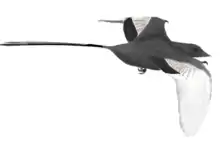 Confuciusornis, a genus of crow-sized birds from the Early Cretaceous
Confuciusornis, a genus of crow-sized birds from the Early Cretaceous
Marine fauna
In the seas, rays, modern sharks and teleosts became common.[47] Marine reptiles included ichthyosaurs in the early and mid-Cretaceous (becoming extinct during the late Cretaceous Cenomanian-Turonian anoxic event), plesiosaurs throughout the entire period, and mosasaurs appearing in the Late Cretaceous.
Baculites, an ammonite genus with a straight shell, flourished in the seas along with reef-building rudist clams. The Hesperornithiformes were flightless, marine diving birds that swam like grebes. Globotruncanid Foraminifera and echinoderms such as sea urchins and starfish (sea stars) thrived. The first radiation of the diatoms (generally siliceous shelled, rather than calcareous) in the oceans occurred during the Cretaceous; freshwater diatoms did not appear until the Miocene.[46] The Cretaceous was also an important interval in the evolution of bioerosion, the production of borings and scrapings in rocks, hardgrounds and shells.
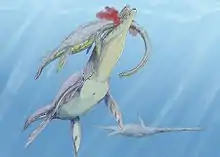 A scene from the early Cretaceous: a Woolungasaurus is attacked by a Kronosaurus.
A scene from the early Cretaceous: a Woolungasaurus is attacked by a Kronosaurus. Tylosaurus was a large mosasaur, carnivorous marine reptiles that emerged in the late Cretaceous.
Tylosaurus was a large mosasaur, carnivorous marine reptiles that emerged in the late Cretaceous.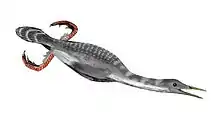 Strong-swimming and toothed predatory waterbird Hesperornis roamed late Cretacean oceans.
Strong-swimming and toothed predatory waterbird Hesperornis roamed late Cretacean oceans.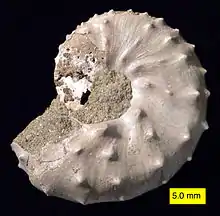 The ammonite Discoscaphites iris, Owl Creek Formation (Upper Cretaceous), Ripley, Mississippi
The ammonite Discoscaphites iris, Owl Creek Formation (Upper Cretaceous), Ripley, Mississippi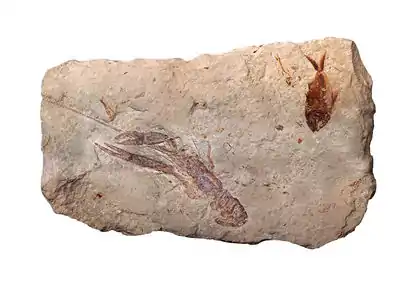 A plate with Nematonotus sp., Pseudostacus sp. and a partial Dercetis triqueter, found in Hakel, Lebanon
A plate with Nematonotus sp., Pseudostacus sp. and a partial Dercetis triqueter, found in Hakel, Lebanon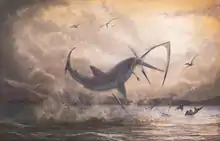 Cretoxyrhina, one of the largest Cretaceous sharks, attacking a Pteranodon in the Western Interior Seaway
Cretoxyrhina, one of the largest Cretaceous sharks, attacking a Pteranodon in the Western Interior Seaway
See also
- Chalk Formation
- Cretaceous Thermal Maximum
- List of fossil sites (with link directory)
- South Polar region of the Cretaceous
References
Citations
- "Cretaceous". Dictionary.com Unabridged. Random House.
- d’Halloy, d’O., J.-J. (1822). "Observations sur un essai de carte géologique de la France, des Pays-Bas, et des contrées voisines" [Observations on a trial geological map of France, the Low Countries, and neighboring countries]. Annales des Mines. 7: 353–376.CS1 maint: multiple names: authors list (link) From page 373: "La troisième, qui correspond à ce qu'on a déja appelé formation de la craie, sera désigné par le nom de terrain crétacé." (The third, which corresponds to what was already called the "chalk formation", will be designated by the name "chalky terrain".)
- Sovetskaya Enciklopediya [Great Soviet Encyclopedia] (in Russian) (3rd ed.). Moscow: Sovetskaya Enciklopediya. 1974. vol. 16, p. 50.
- Glossary of Geology (3rd ed.). Washington, D.C.: American Geological Institute. 1972. p. 165.
- Ogg, J.G.; Hinnov, L.A.; Huang, C. (2012), "Cretaceous", The Geologic Time Scale, Elsevier, pp. 793–853, doi:10.1016/b978-0-444-59425-9.00027-5, ISBN 978-0-444-59425-9, retrieved 2021-01-08
- Gradstein, F.M.; Ogg, J.G.; Schmitz, M.D.; Ogg, G.M. (editors) (2012). The Geologic Timescale 2012. Elsevier. p. 795. ISBN 978-0-44-459390-0.CS1 maint: uses authors parameter (link)
- Renne, Paul R.; et al. (2013). "Time scales of critical events around the Cretaceous-Paleogene boundary". Science. 339 (6120): 684–688. Bibcode:2013Sci...339..684R. doi:10.1126/science.1230492. PMID 23393261. S2CID 6112274.
- Vennari, Verónica V.; Lescano, Marina; Naipauer, Maximiliano; Aguirre-Urreta, Beatriz; Concheyro, Andrea; Schaltegger, Urs; Armstrong, Richard; Pimentel, Marcio; Ramos, Victor A. (2014). "New constraints on the Jurassic–Cretaceous boundary in the High Andes using high-precision U–Pb data". Gondwana Research. 26 (1): 374–385. Bibcode:2014GondR..26..374V. doi:10.1016/j.gr.2013.07.005.
- Jaramillo, Jessica. "Entrevista al Dr. Víctor Alberto Ramos, Premio México Ciencia y Tecnología 2013" (in Spanish).
Si logramos publicar esos nuevos resultados, sería el primer paso para cambiar formalmente la edad del Jurásico-Cretácico. A partir de ahí, la Unión Internacional de la Ciencias Geológicas y la Comisión Internacional de Estratigrafía certificaría o no, depende de los resultados, ese cambio.
- MacLeod, N; Rawson, PF; Forey, PL; Banner, FT; Boudagher-Fadel, MK; Bown, PR; Burnett, JA; et al. (1997). "The Cretaceous–Tertiary biotic transition". Journal of the Geological Society. 154 (2): 265–292. Bibcode:1997JGSoc.154..265M. doi:10.1144/gsjgs.154.2.0265. S2CID 129654916.
- Wilf, P; Johnson KR (2004). "Land plant extinction at the end of the Cretaceous: a quantitative analysis of the North Dakota megafloral record". Paleobiology. 30 (3): 347–368. doi:10.1666/0094-8373(2004)030<0347:LPEATE>2.0.CO;2.
- Kauffman, E (2004). "Mosasaur Predation on Upper Cretaceous Nautiloids and Ammonites from the United States Pacific Coast". PALAIOS. 19 (1): 96–100. Bibcode:2004Palai..19...96K. doi:10.1669/0883-1351(2004)019<0096:MPOUCN>2.0.CO;2.
- Shehan, P; Hansen, TA (1986). "Detritus feeding as a buffer to extinction at the end of the Cretaceous". Geology. 14 (10): 868–870. Bibcode:1986Geo....14..868S. doi:10.1130/0091-7613(1986)14<868:DFAABT>2.0.CO;2.
- Aberhan, M; Weidemeyer, S; Kieesling, W; Scasso, RA & Medina, FA (2007). "Faunal evidence for reduced productivity and uncoordinated recovery in Southern Hemisphere Cretaceous–Paleogene boundary sections". Geology. 35 (3): 227–230. Bibcode:2007Geo....35..227A. doi:10.1130/G23197A.1.
- Sheehan, PM; Fastovsky, DE (1992). "Major extinctions of land-dwelling vertebrates at the Cretaceous–Paleogene boundary, eastern Montana". Geology. 20 (6): 556–560. Bibcode:1992Geo....20..556S. doi:10.1130/0091-7613(1992)020<0556:MEOLDV>2.3.CO;2.
- Stanley 1999, pp. 481–482.
- Weimar, R.J. (1960). "Upper Cretaceous Stratigraphy, Rocky Mountain Area". AAPG Bulletin. 44: 1-20. doi:10.1306/0BDA5F6F-16BD-11D7-8645000102C1865D.
- Brownstein, Chase D (2018). "The biogeography and ecology of the Cretaceous non-avian dinosaurs of Appalachia". Palaeontologia Electronica. 21: 1–56. doi:10.26879/801.
- Dixon, Dougal; Benton, M J; Kingsley, Ayala; Baker, Julian (2001). Atlas of Life on Earth. New York: Barnes & Noble Books. p. 215. ISBN 9780760719572.
- Stanley 1999, p. 280.
- Stanley 1999, pp. 279–281.
- Kazlev, M.Alan. "Palaeos Mesozoic: Cretaceous: The Berriasian Age". Palaeos.com. Archived from the original on 20 December 2010. Retrieved 18 October 2017.
- Alley, N. F.; Frakes, L. A. (2003). "First known Cretaceous glaciation: Livingston Tillite Member of the Cadna‐owie Formation, South Australia". Australian Journal of Earth Sciences. 50 (2): 139–144. Bibcode:2003AuJES..50..139A. doi:10.1046/j.1440-0952.2003.00984.x. S2CID 128739024.
- Frakes, L. A.; Francis, J. E. (1988). "A guide to Phanerozoic cold polar climates from high-latitude ice-rafting in the Cretaceous". Nature. 333 (6173): 547–549. Bibcode:1988Natur.333..547F. doi:10.1038/333547a0. S2CID 4344903.
- Nordt, Lee; Atchley, Stacy; Dworkin, Steve (December 2003). "Terrestrial Evidence for Two Greenhouse Events in the Latest Cretaceous". GSA Today. Vol. 13 no. 12. doi:10.1130/1052-5173(2003)013<4:TEFTGE>2.0.CO;2.
- Foulger, G.R. (2010). Plates vs. Plumes: A Geological Controversy. Wiley-Blackwell. ISBN 978-1-4051-6148-0.
- Stanley 1999, p. 480–482.
- Bornemann, Norris RD; Friedrich, O; Beckmann, B; Schouten, S; Damsté, JS; Vogel, J; Hofmann, P; Wagner, T (Jan 2008). "Isotopic evidence for glaciation during the Cretaceous supergreenhouse". Science. 319 (5860): 189–92. Bibcode:2008Sci...319..189B. doi:10.1126/science.1148777. PMID 18187651. S2CID 206509273.
- Huber, Brian T.; MacLeod, Kenneth G.; Watkins, David K.; Coffin, Millard F. (2018-08-01). "The rise and fall of the Cretaceous Hot Greenhouse climate". Global and Planetary Change. 167: 1–23. doi:10.1016/j.gloplacha.2018.04.004. hdl:1912/10514. ISSN 0921-8181.
- the Science Team of Expedition PS104; Klages, Johann P.; Salzmann, Ulrich; Bickert, Torsten; Hillenbrand, Claus-Dieter; Gohl, Karsten; Kuhn, Gerhard; Bohaty, Steven M.; Titschack, Jürgen; Müller, Juliane; Frederichs, Thomas (April 2020). "Temperate rainforests near the South Pole during peak Cretaceous warmth". Nature. 580 (7801): 81–86. doi:10.1038/s41586-020-2148-5. ISSN 0028-0836.
- "Warmer than a Hot Tub: Atlantic Ocean Temperatures Much Higher in the Past" PhysOrg.com. Retrieved 12/3/06.
- Skinner & Porter 1995, p. 557.
- Friis EM, Crane PR, Pedersen KR, Bengtson S, Donoghue PC, Grimm GW, Stampanoni M (November 2007). "Phase-contrast X-ray microtomography links Cretaceous seeds with Gnetales and Bennettitales". Nature. 450 (7169): 549–52. doi:10.1038/nature06278. PMID 18033296.
- Ran, Jin-Hua; Shen, Ting-Ting; Wang, Ming-Ming; Wang, Xiao-Quan (2018-06-27). "Phylogenomics resolves the deep phylogeny of seed plants and indicates partial convergent or homoplastic evolution between Gnetales and angiosperms". Proceedings of the Royal Society B: Biological Sciences. 285 (1881): 20181012. doi:10.1098/rspb.2018.1012. ISSN 0962-8452. PMC 6030518. PMID 29925623.
- Herendeen, Patrick S.; Friis, Else Marie; Pedersen, Kaj Raunsgaard; Crane, Peter R. (March 2017). "Palaeobotanical redux: revisiting the age of the angiosperms". Nature Plants. 3 (3). doi:10.1038/nplants.2017.15. ISSN 2055-0278.
- Brenner, G.J. (1996). "Evidence for the earliest stage of angiosperm pollen evolution: a paleoequatorial section from Israel". In Taylor, D.W.; Hickey, L.J. (eds.). Flowering plant origin, evolution & phylogeny. New York: Chapman & Hall. pp. 91–115. doi:10.1007/978-0-585-23095-5_5. ISBN 978-0-585-23095-5.
- Trevisan L. 1988. Angiospermous pollen (monosulcate–trichotomosulcate phase) from the very early Lower Cretaceous of southern Tuscany (Italy): some aspects. 7th International Palynological Congress Abstracts Volume. Brisbane, Australia: University of Queensland, 165.
- Coiro, Mario; Doyle, James A.; Hilton, Jason (July 2019). "How deep is the conflict between molecular and fossil evidence on the age of angiosperms?". New Phytologist. 223 (1): 83–99. doi:10.1111/nph.15708. ISSN 0028-646X.
- Wu, Yan; You, Hai-Lu; Li, Xiao-Qiang (2018-09-01). "Dinosaur-associated Poaceae epidermis and phytoliths from the Early Cretaceous of China". National Science Review. 5 (5): 721–727. doi:10.1093/nsr/nwx145. ISSN 2095-5138.
- Prasad, V.; Strömberg, C. a. E.; Leaché, A. D.; Samant, B.; Patnaik, R.; Tang, L.; Mohabey, D. M.; Ge, S.; Sahni, A. (2011-09-20). "Late Cretaceous origin of the rice tribe provides evidence for early diversification in Poaceae". Nature Communications. 2 (1): 480. doi:10.1038/ncomms1482. ISSN 2041-1723.
- Jud, Nathan A.; D’Emic, Michael D.; Williams, Scott A.; Mathews, Josh C.; Tremaine, Katie M.; Bhattacharya, Janok (September 2018). "A new fossil assemblage shows that large angiosperm trees grew in North America by the Turonian (Late Cretaceous)". Science Advances. 4 (9): eaar8568. doi:10.1126/sciadv.aar8568. ISSN 2375-2548. PMC 6157959. PMID 30263954.
- Regalado, Ledis; Schmidt, Alexander R.; Müller, Patrick; Niedermeier, Lisa; Krings, Michael; Schneider, Harald (July 2019). "Heinrichsia cheilanthoides gen. et sp. nov., a fossil fern in the family Pteridaceae (Polypodiales) from the Cretaceous amber forests of Myanmar". Journal of Systematics and Evolution. 57 (4): 329–338. doi:10.1111/jse.12514. ISSN 1674-4918.
- Kielan-Jaworowska, Zofia; Cifelli, Richard L.; Luo, Zhe-Xi (2005). Mammals from the Age of Dinosaurs: Origins, Evolution, and Structure. Columbia University Press. p. 299. ISBN 9780231119184.
- Halliday, Thomas John Dixon; Upchurch, Paul; Goswami, Anjali (29 June 2016). "Eutherians experienced elevated evolutionary rates in the immediate aftermath of the Cretaceous–Palaeogene mass extinction". Proc. R. Soc. B. 283 (1833): 20153026. doi:10.1098/rspb.2015.3026. PMC 4936024. PMID 27358361.
- Wilton, Mark P. (2013). Pterosaurs: Natural History, Evolution, Anatomy. Princeton University Press. ISBN 978-0691150611.
- "Life of the Cretaceous". www.ucmp.Berkeley.edu. Retrieved 18 October 2017.
- "EVOLUTIONARY/GEOLOGICAL TIMELINE v1.0". www.TalkOrigins.org. Retrieved 18 October 2017.
Bibliography
- Yuichiro Kashiyama; Nanako O. Ogawa; Junichiro Kuroda; Motoo Shiro; Shinya Nomoto; Ryuji Tada; Hiroshi Kitazato; Naohiko Ohkouchi (May 2008). "Diazotrophic cyanobacteria as the major photoautotrophs during mid-Cretaceous oceanic anoxic events: Nitrogen and carbon isotopic evidence from sedimentary porphyrin". Organic Geochemistry. 39 (5): 532–549. doi:10.1016/j.orggeochem.2007.11.010.
- Larson, Neal L; Jorgensen, Steven D; Farrar, Robert A; Larson, Peter L (1997). Ammonites and the other Cephalopods of the Pierre Seaway. Geoscience Press.
- Ogg, Jim (June 2004). "Overview of Global Boundary Stratotype Sections and Points (GSSP's)". Archived from the original on 16 July 2006.
- Ovechkina, M.N.; Alekseev, A.S. (2005). "Quantitative changes of calcareous nannoflora in the Saratov region (Russian Platform) during the late Maastrichtian warming event" (PDF). Journal of Iberian Geology. 31 (1): 149–165. Archived from the original (PDF) on August 24, 2006.
- Rasnitsyn, A.P.; Quicke, D.L.J. (2002). History of Insects. Kluwer Academic Publishers. ISBN 978-1-4020-0026-3.—detailed coverage of various aspects of the evolutionary history of the insects.
- Skinner, Brian J.; Porter, Stephen C. (1995). The Dynamic Earth: An Introduction to Physical Geology (3rd ed.). New York: John Wiley & Sons. ISBN 0-471-60618-9.
- Stanley, Steven M. (1999). Earth System History. New York: W.H. Freeman and Company. ISBN 0-7167-2882-6.
- Taylor, P. D.; Wilson, M. A. (2003). "Palaeoecology and evolution of marine hard substrate communities". Earth-Science Reviews. 62 (1): 1–103. Bibcode:2003ESRv...62....1T. doi:10.1016/S0012-8252(02)00131-9.
External links
| Wikimedia Commons has media related to Cretaceous. |
| Look up cretaceous in Wiktionary, the free dictionary. |
- UCMP Berkeley Cretaceous page
- Cretaceous Microfossils: 180+ images of Foraminifera
- Cretaceous (chronostratigraphy scale)
- . Encyclopædia Britannica. 7 (11th ed.). 1911. pp. 414–418.
